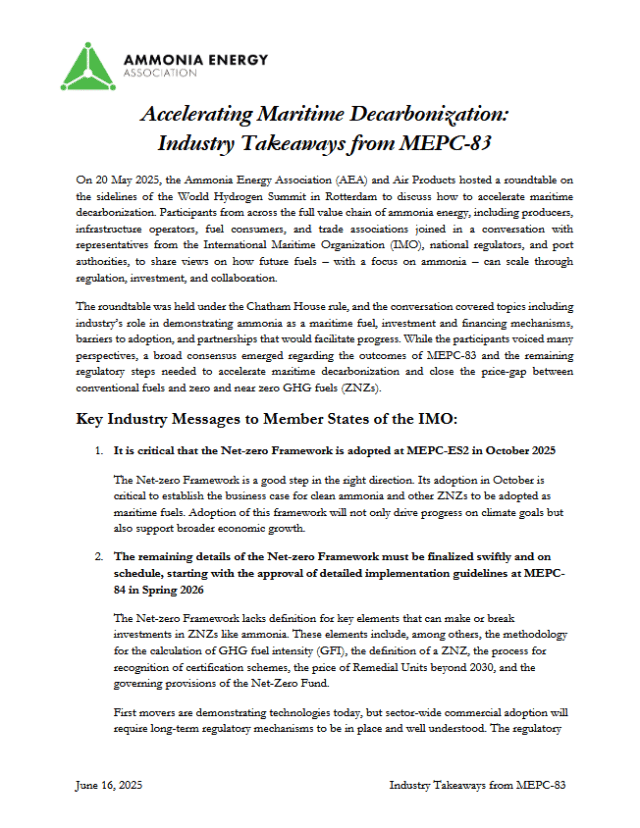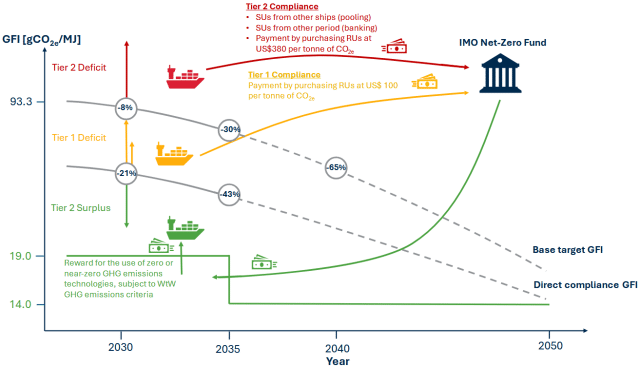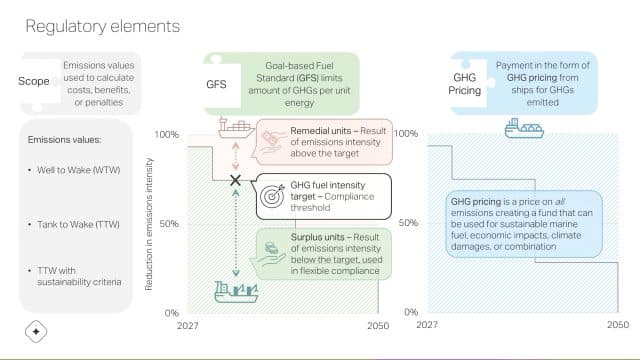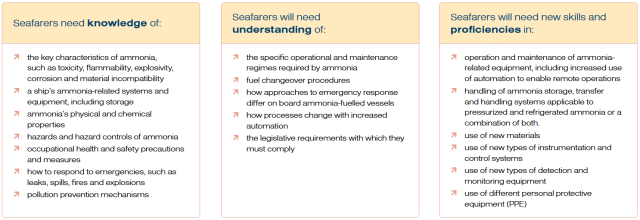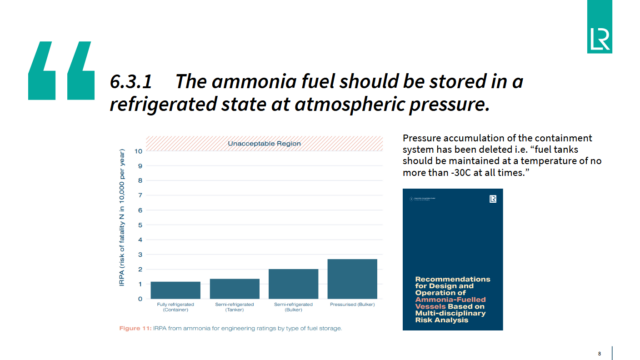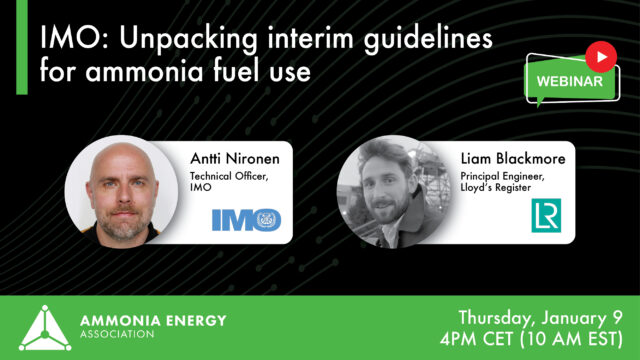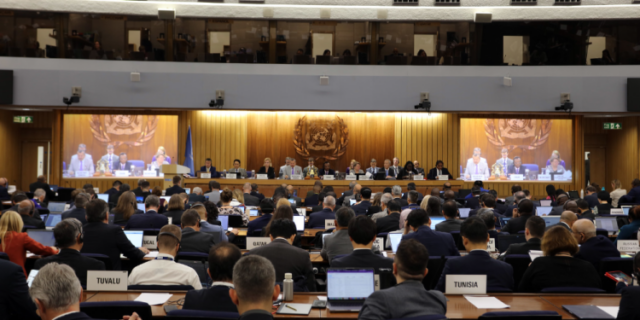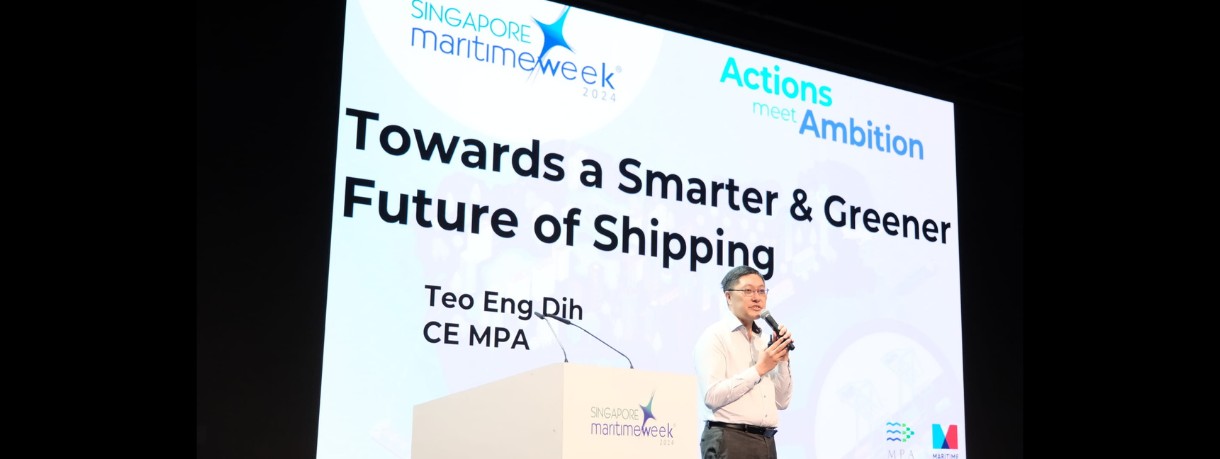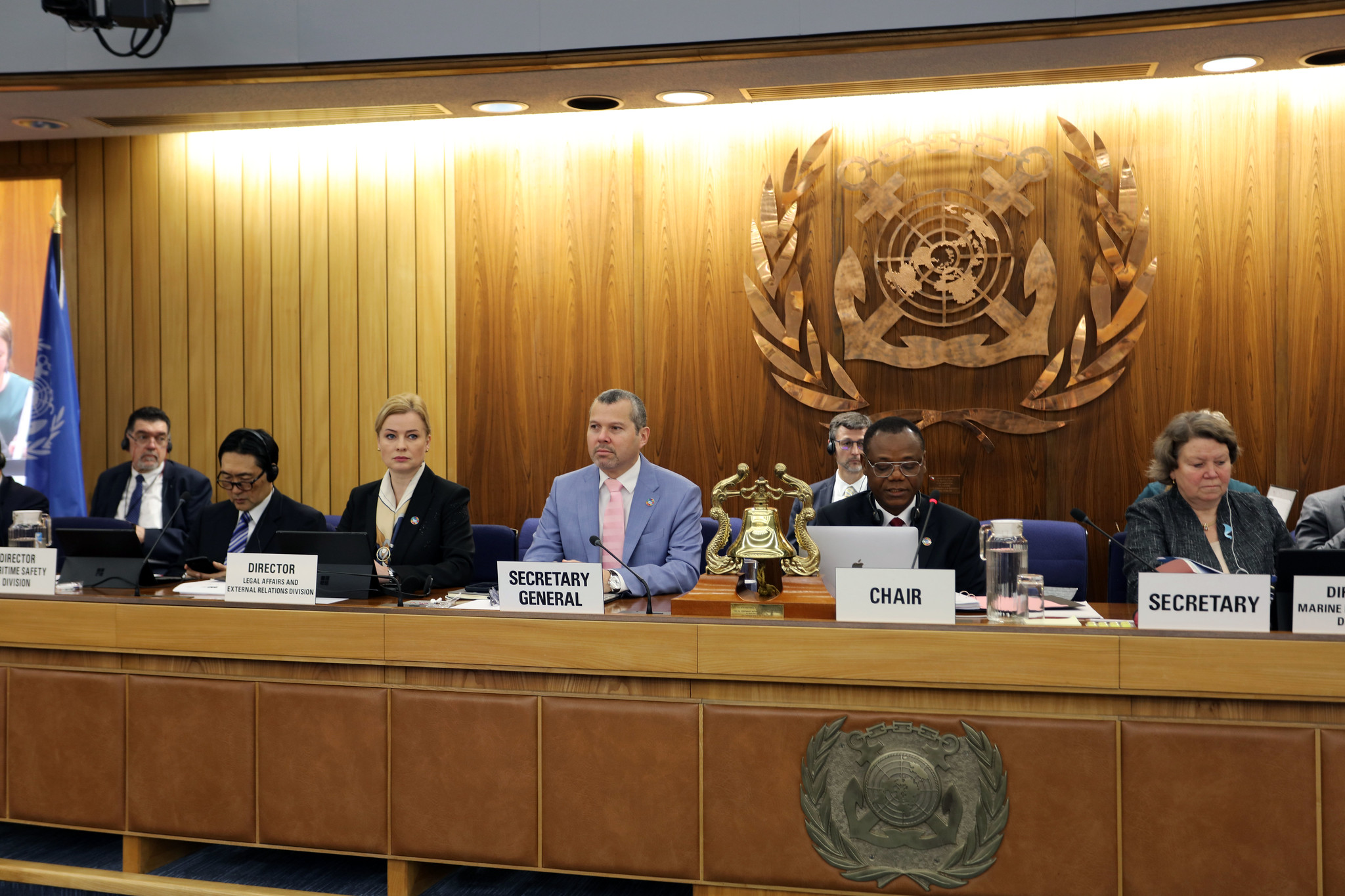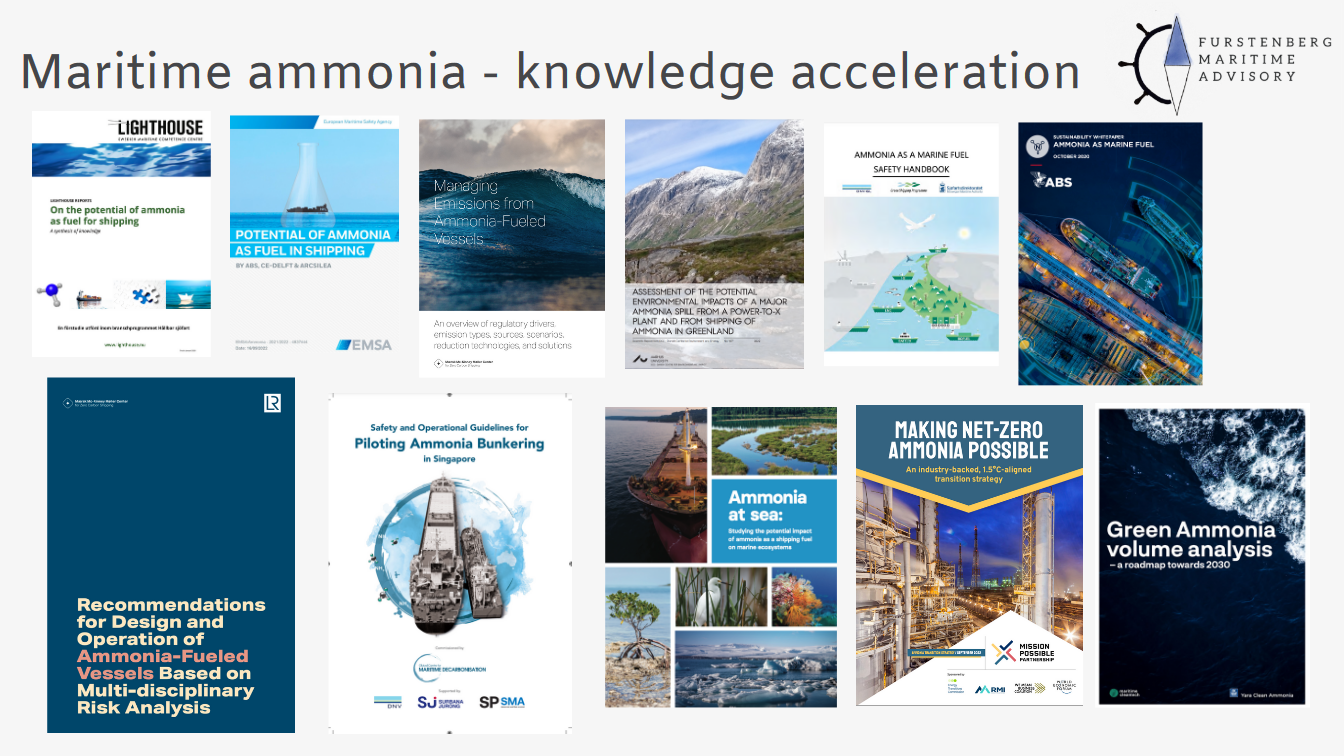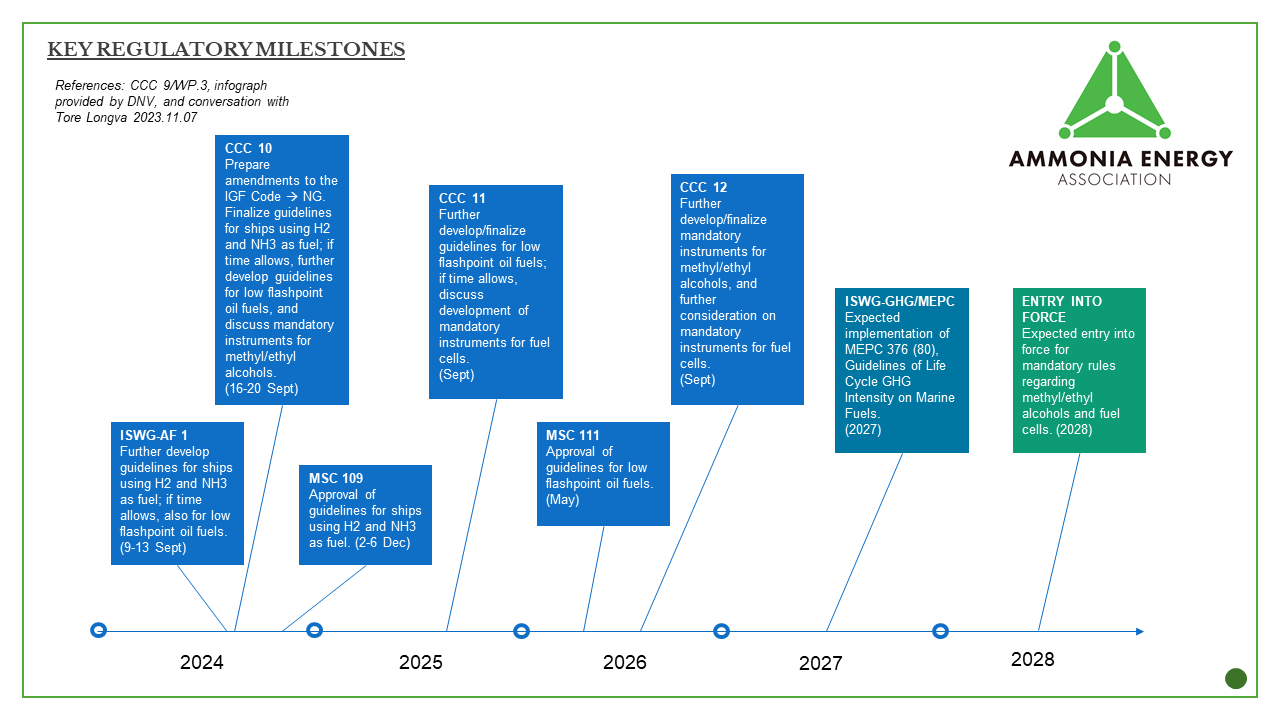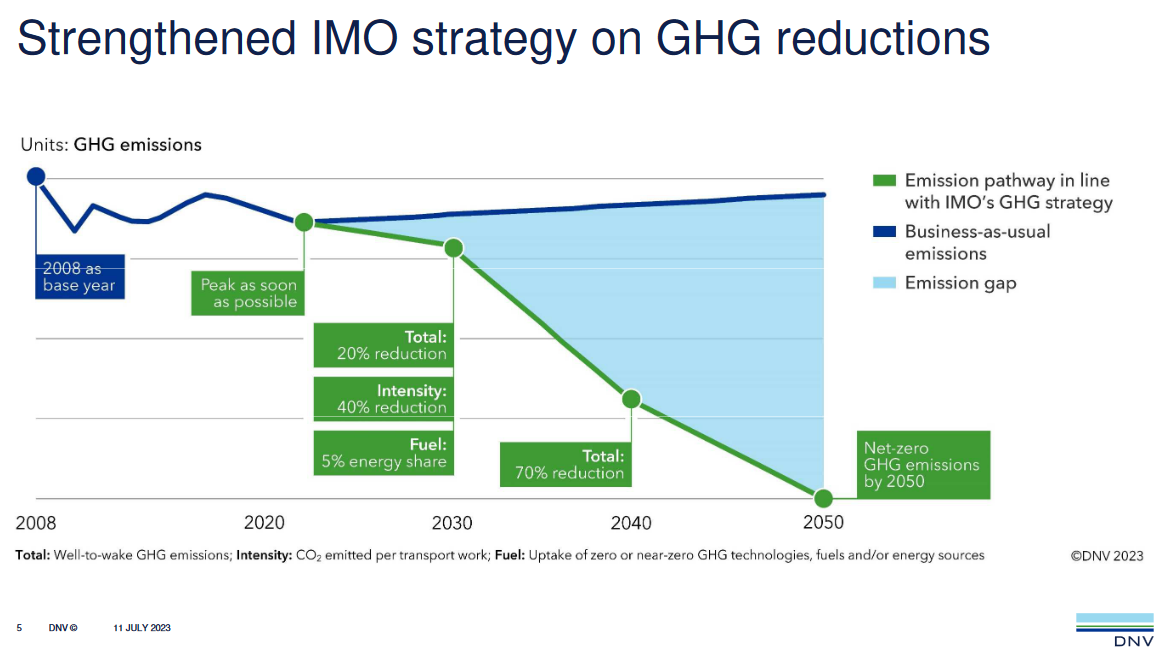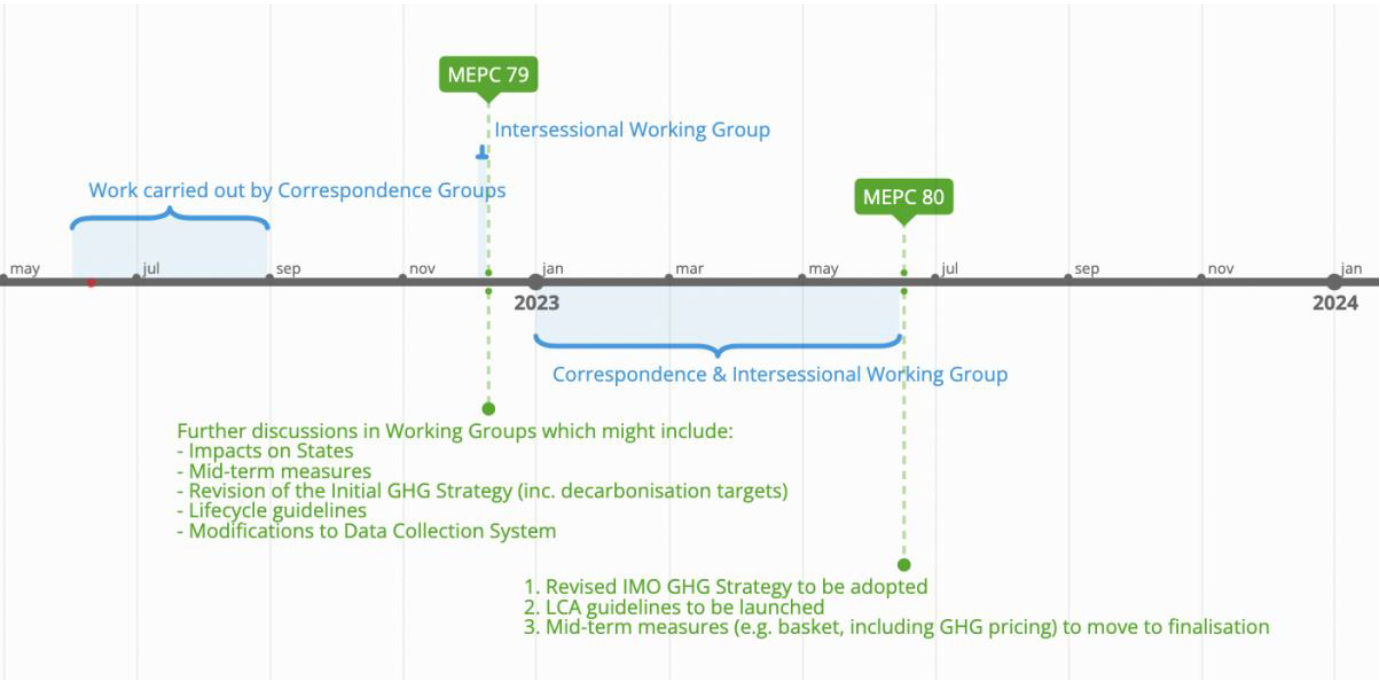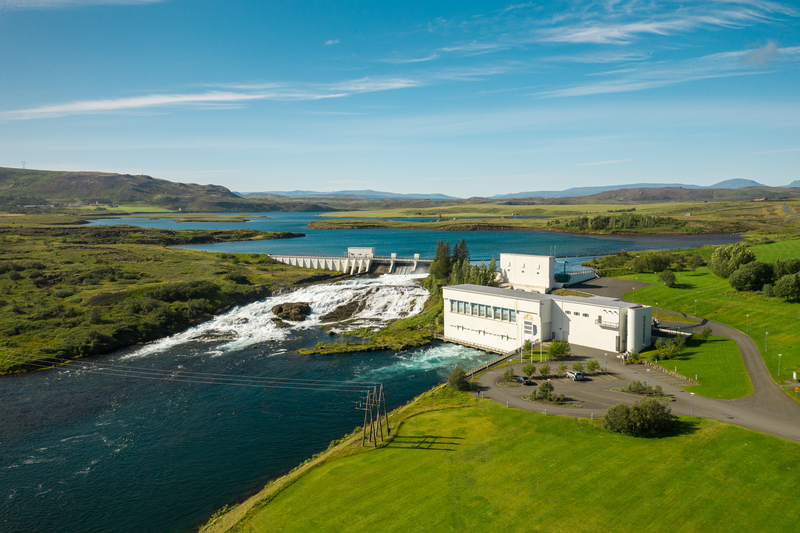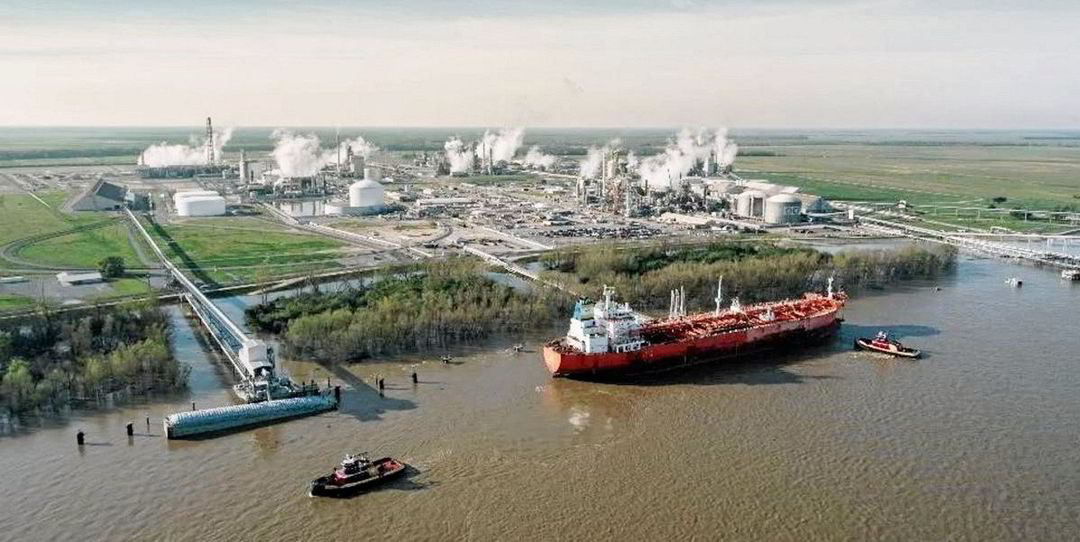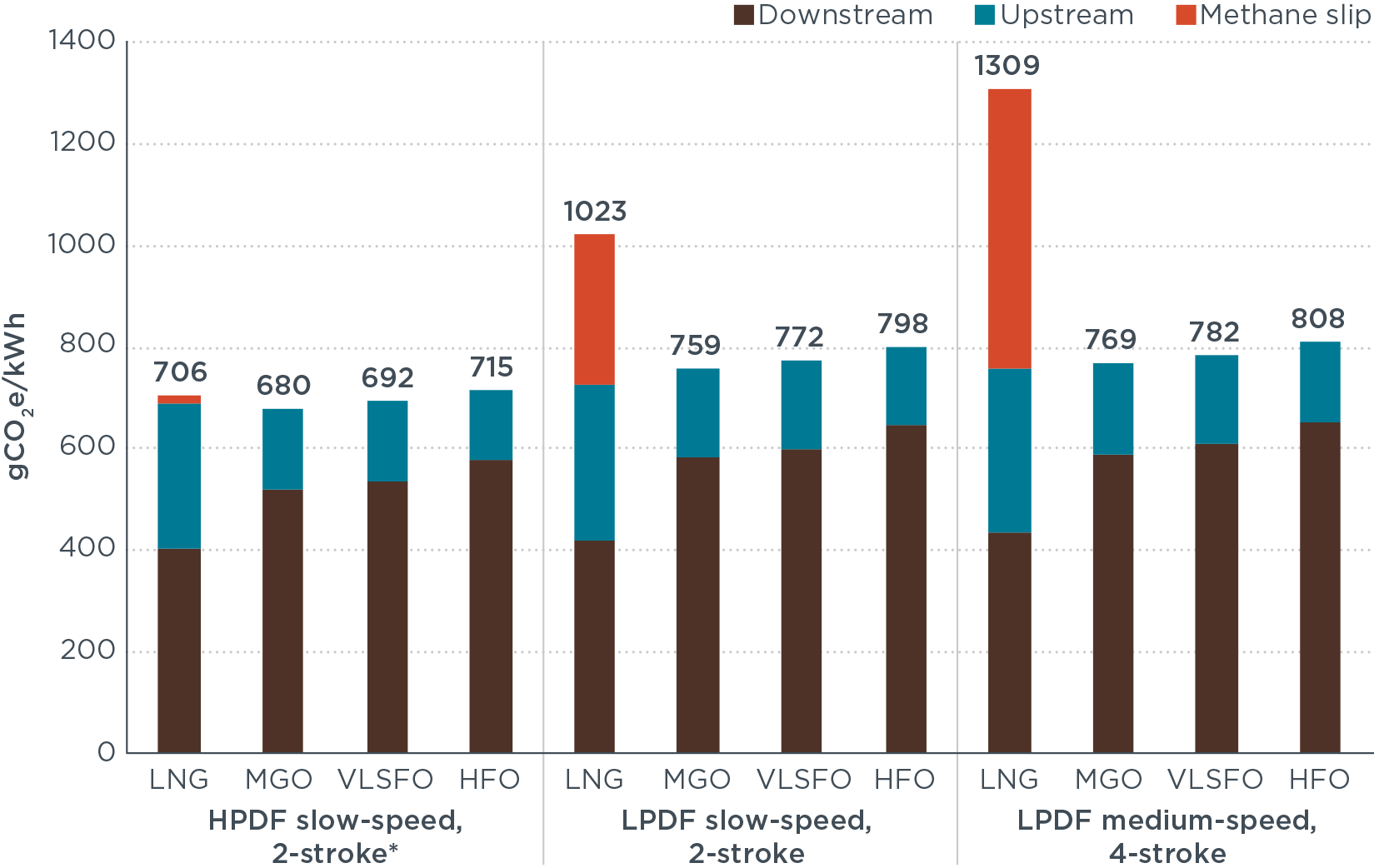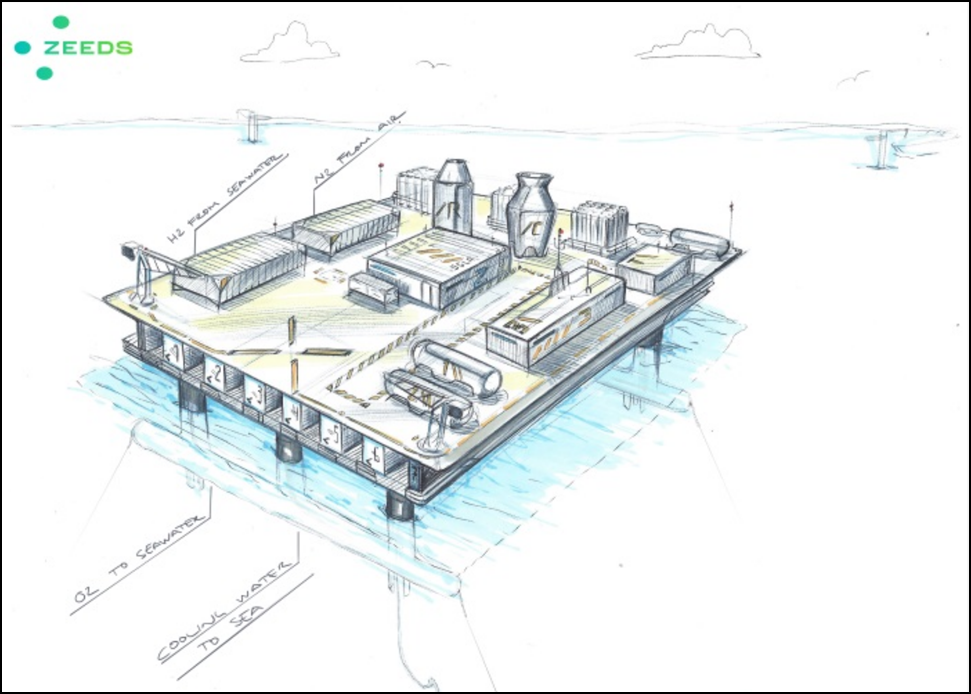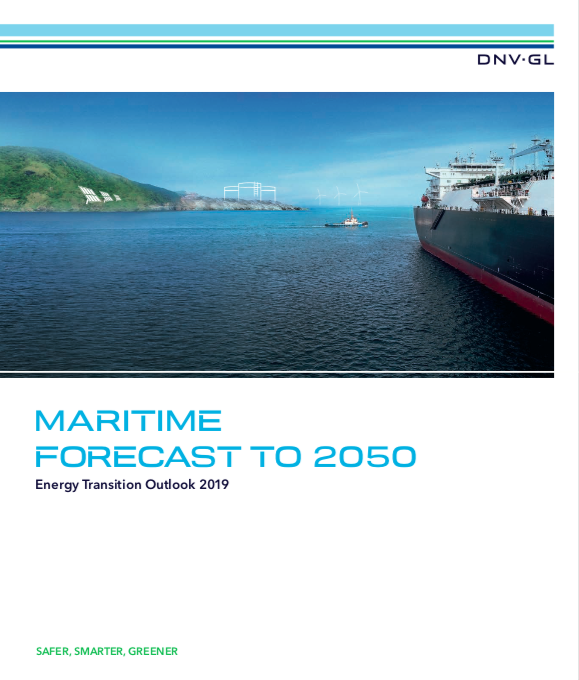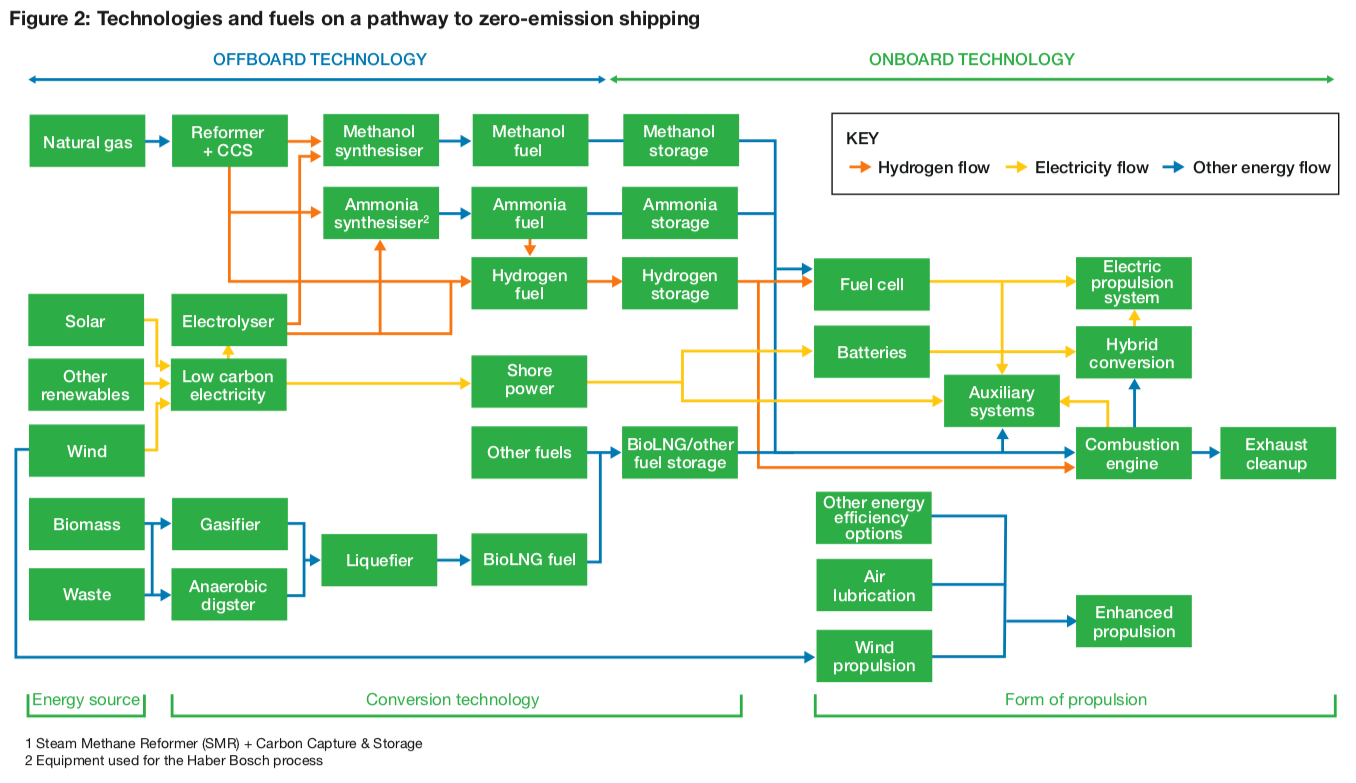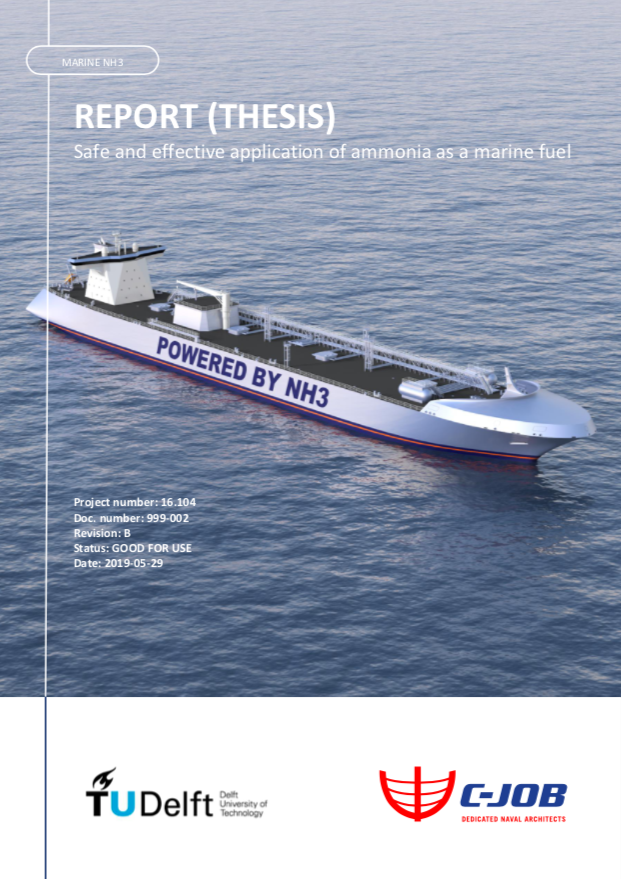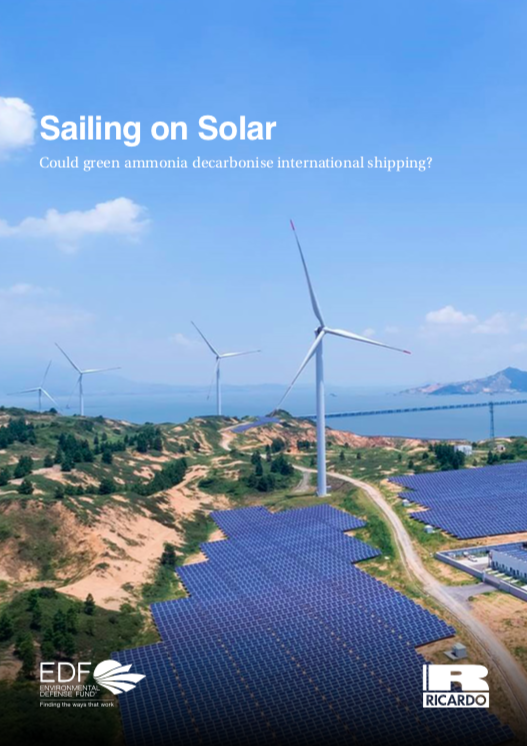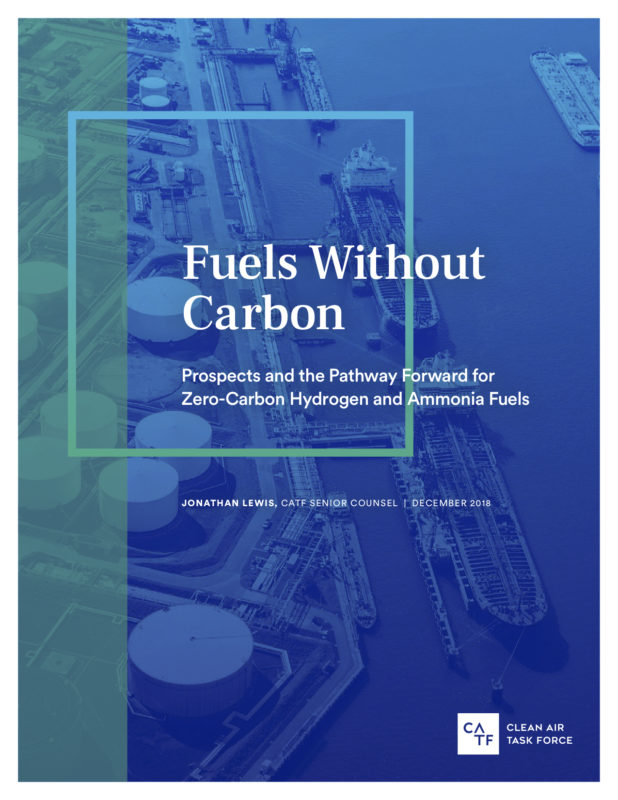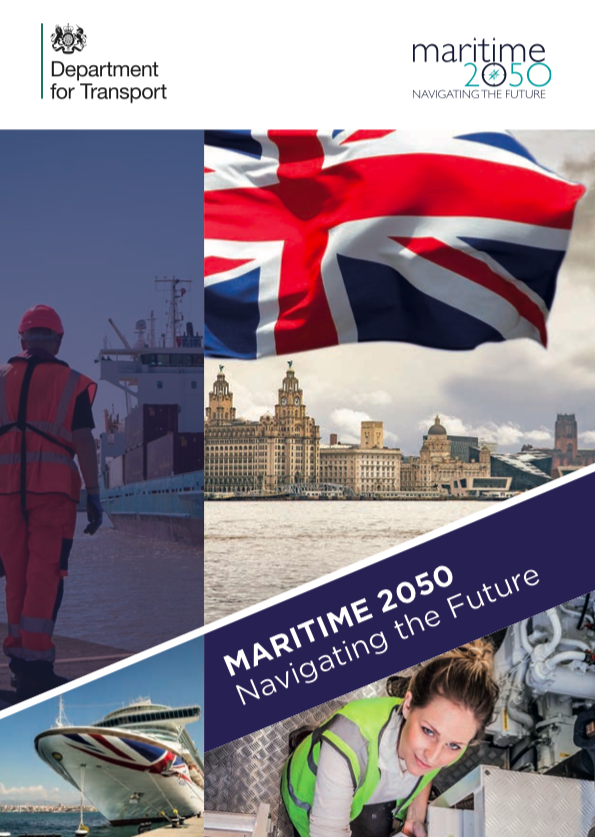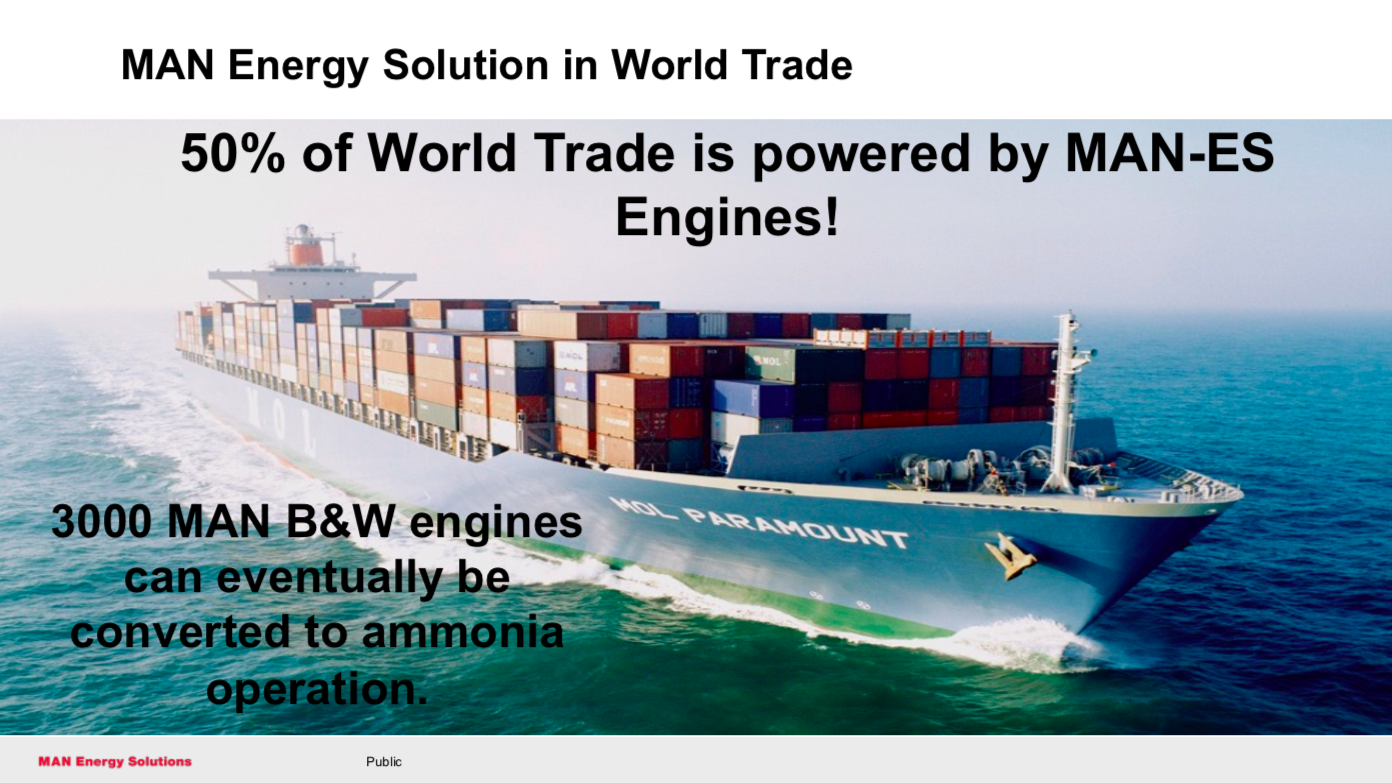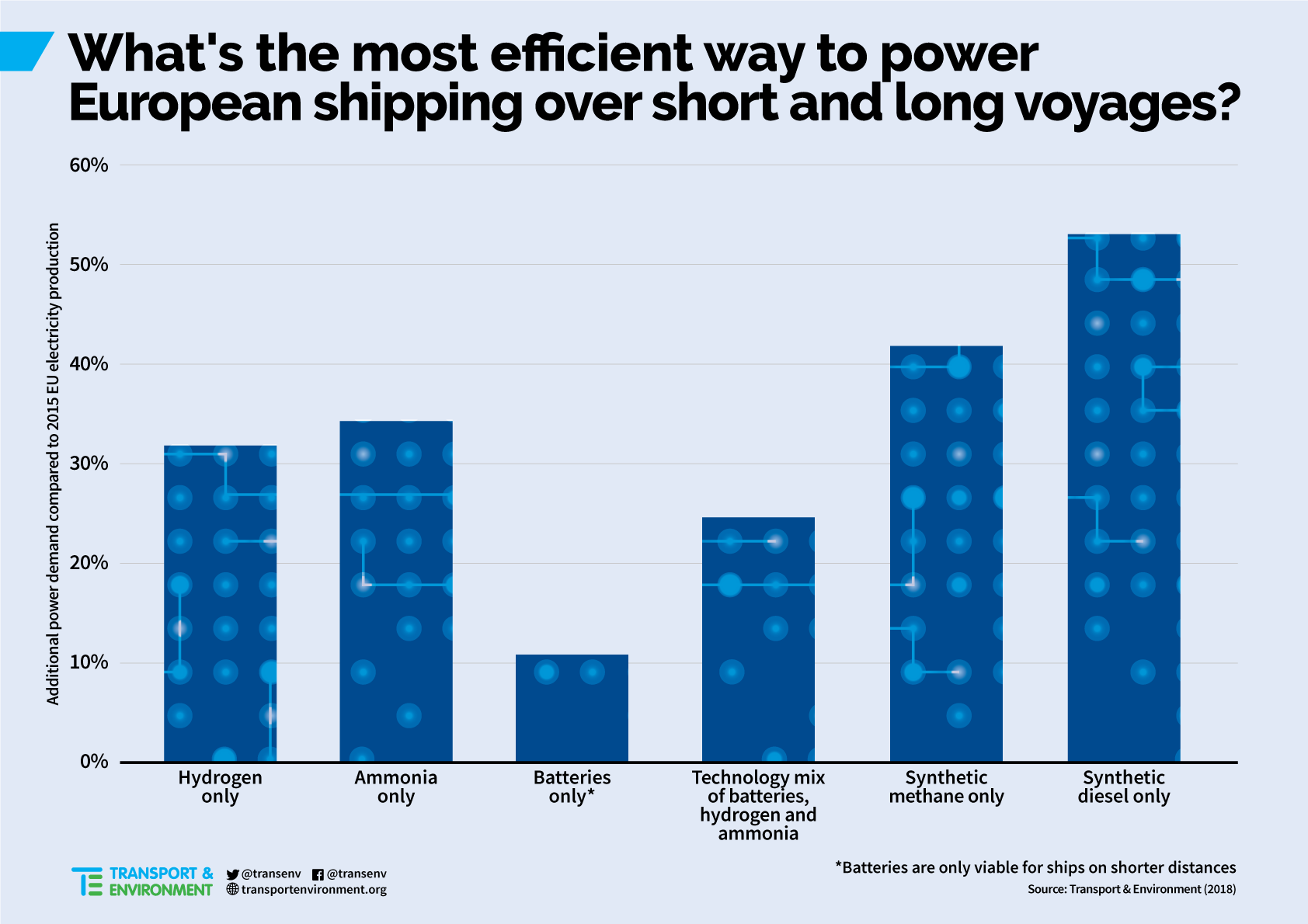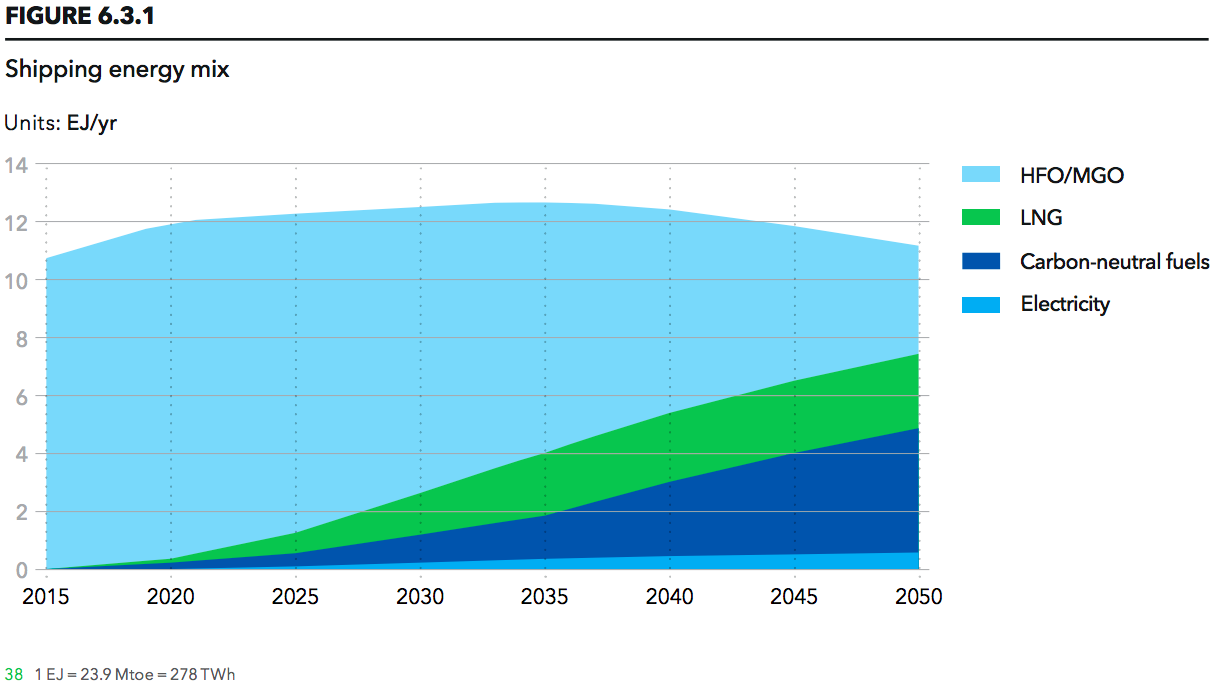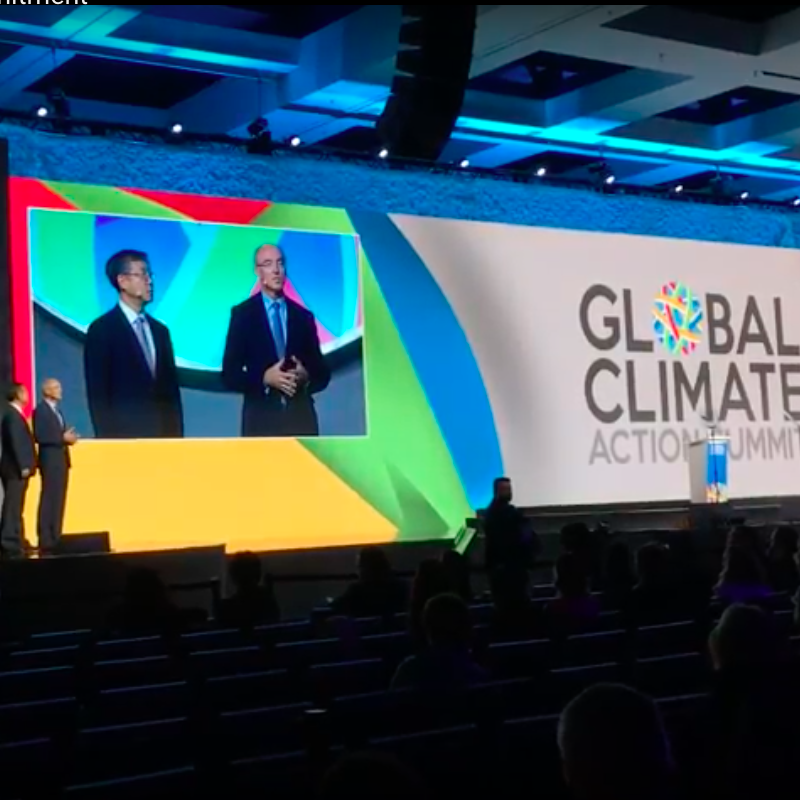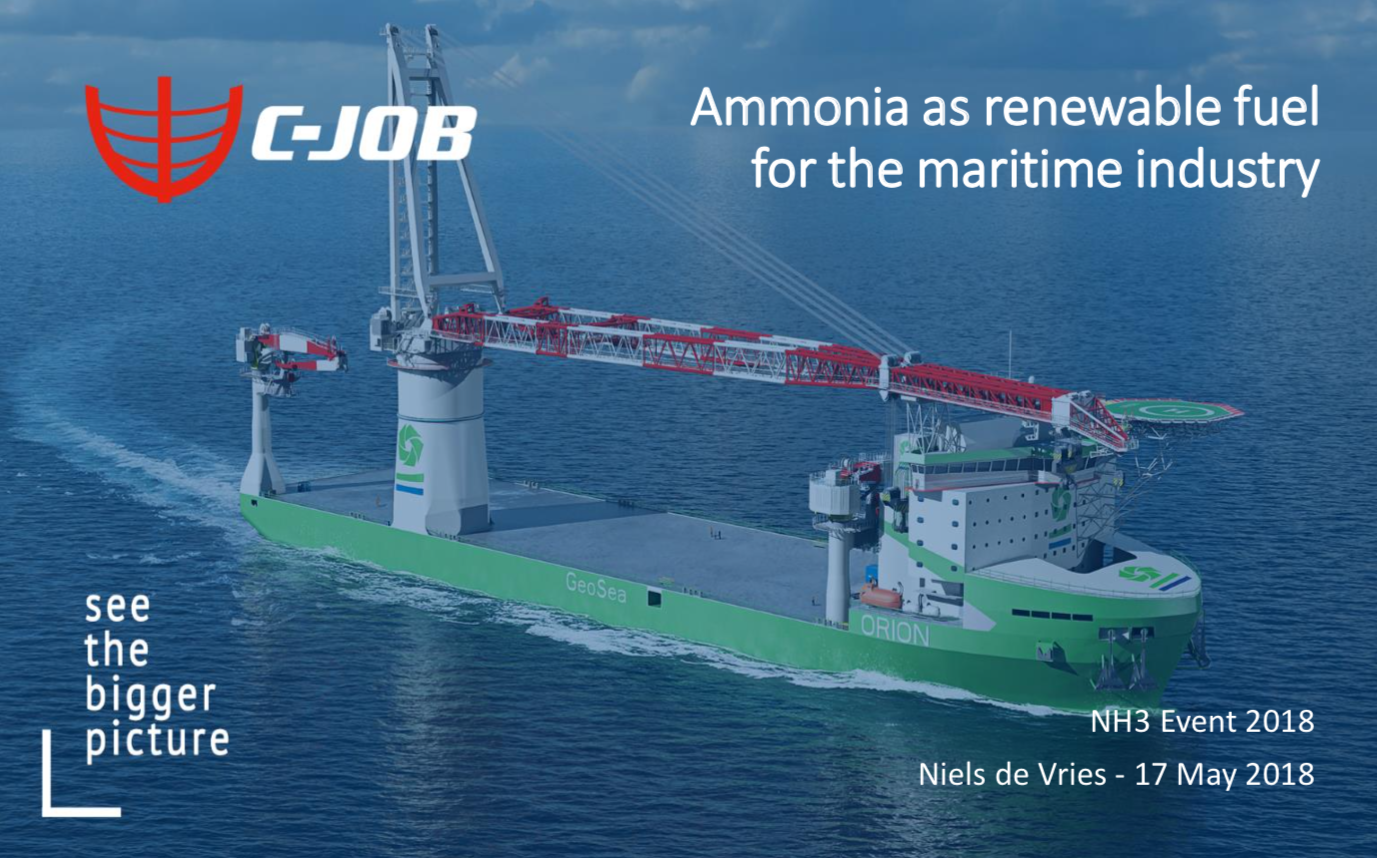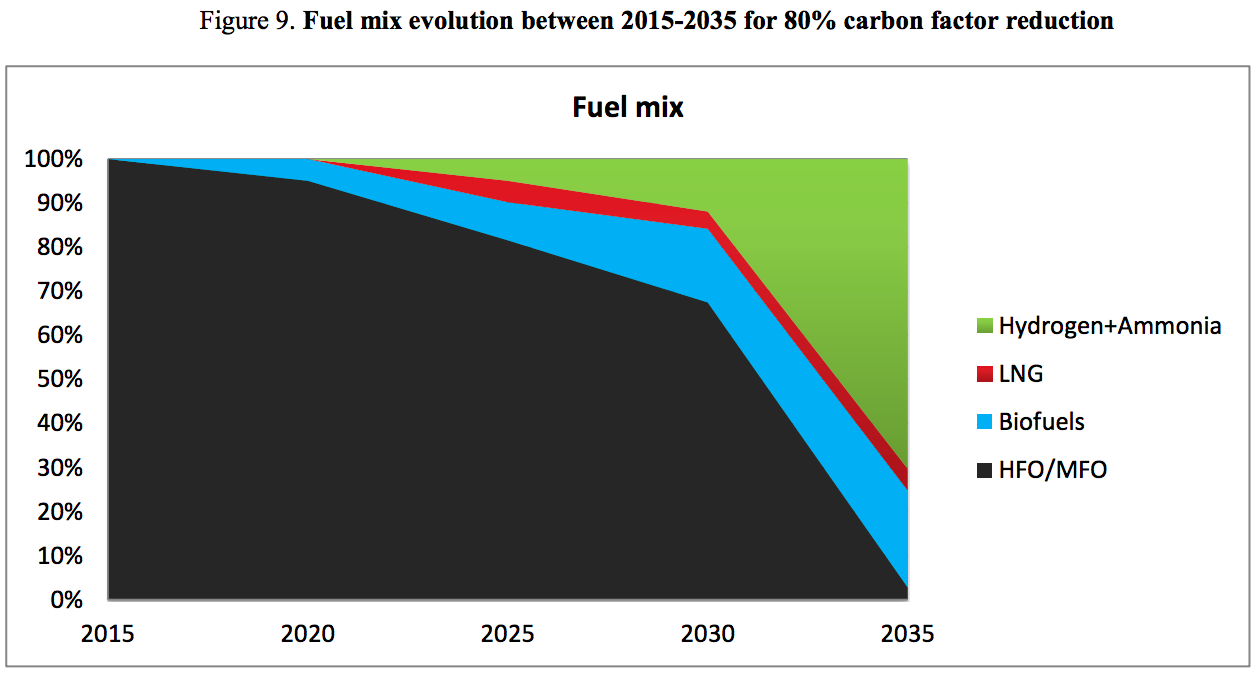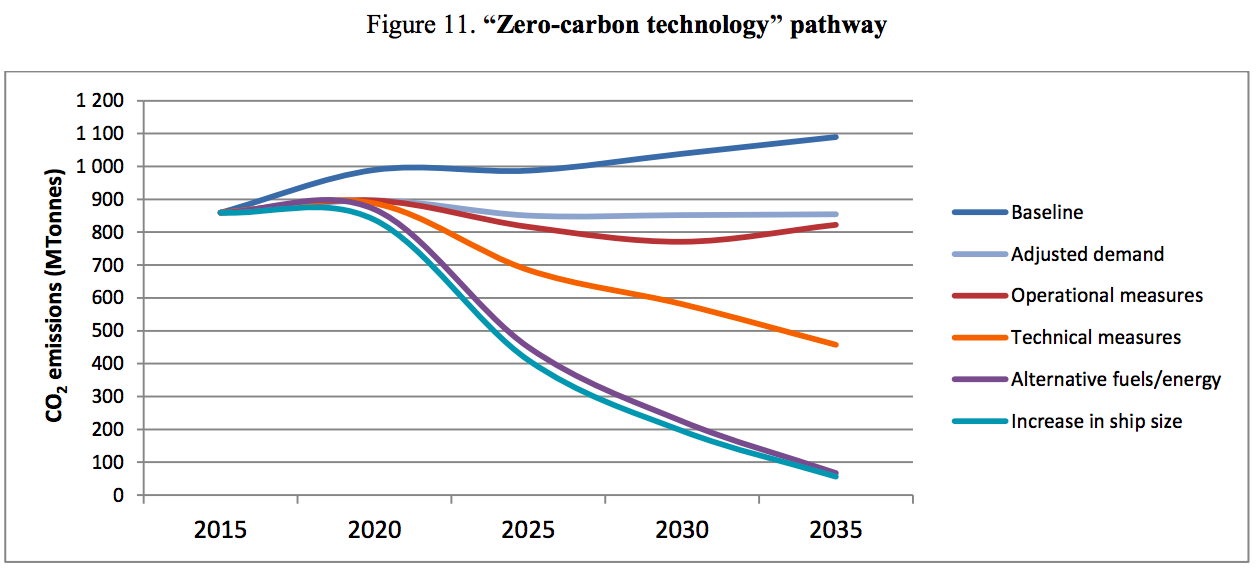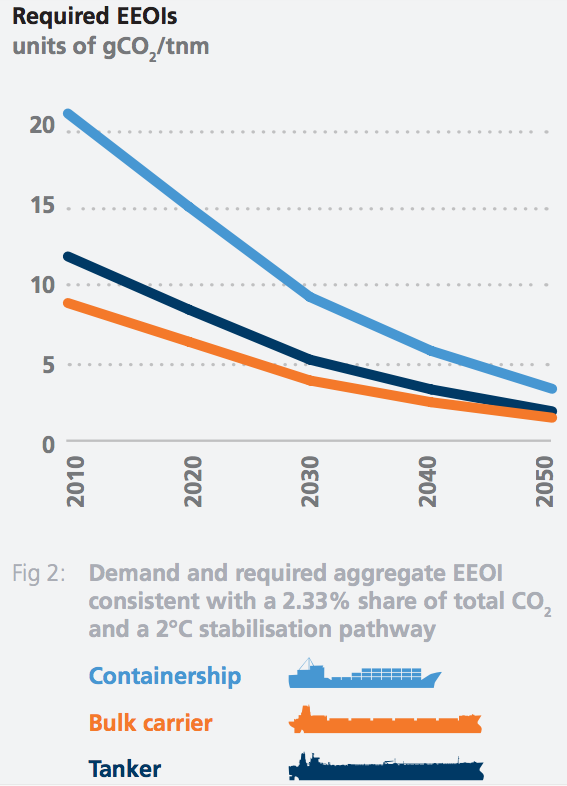The outcome leaves the global shipping industry with a target to achieve net-zero emissions by 2050, but – for now – no detailed pathway to reach those targets. The result also leaves a certainty gap, delaying critical investment in zero or near-zero (ZNZ) fuels and propulsion technologies. Despite the setback, work on finer details and mechanisms to be included in the framework continued this week in London.
Content Related to International Maritime Organization (IMO)
Article
Maritime Just Transition Task Force: interim training frameworks unveiled for seafarers on alternative-fuel-powered vessels
Geofrey Njovu October 02, 2025
The IMO-backed Maritime Just Transition Task Force has unveiled interim frameworks for training seafarers on vessels powered by alternative fuels such as ammonia, methanol and hydrogen. The frameworks will provide guidance before harmonised training standards are fully developed.
Article
Interim guidelines finalized for the use of ammonia cargo as fuel
Julian Atchison September 30, 2025
The first-ever guidelines for use of anhydrous ammonia cargo as fuel on gas carriers have been finalized by the IMO’s Sub-Committee on Carriage of Cargoes and Containers. The guidelines will add supplementary text to the existing IGC Code, adding in specific design and operational requirements for ammonia-fueled vessels.
Article
The IMO approved its Net-zero Framework. Now what?
Trevor BrownAndrea Guati Rojo June 26, 2025
The consensus that has emerged from across the ammonia energy industry carries a very simple message for the IMO: adopt.
Article
MEPC 83: global shipping gets its first-ever emissions pricing mechanism
Julian Atchison April 23, 2025
The regulations send a clear signal to industry – business as usual operations will become significantly more expensive, and zero or near-zero (ZNZ) technologies and fuels represent one of the better opportunities to make deep emissions cuts. Following the historic vote at the IMO, we explore critical timelines for the new regulations, compliance thresholds, mechanisms for vessels to comply, and uncertainties that remain.
Article
Setting the scene for ammonia maritime fuel: regulatory needs and timelines to decarbonize shipping
2025 is a critical year for the adoption of ammonia fuel in shipping. Here, we preview important upcoming meetings of the International Maritime Organization, what regulatory gaps are being filled by this work, potential candidates for decarbonization measures, and progress in engine development. All this sets the scene for incredible progress to be made in the coming years.
Article
Seafarer training for marine ammonia fuel comes into focus
Julian Atchison March 12, 2025
Already in 2025, we have seen multiple initiatives launched and resources released to contribute to seafarer training ahead of the first ammonia-fueled vessels. Here, we explore the IMO’s first training guidelines, a new bunker training facility in India, and a safe procedures manual for ammonia bunkering developed by Copenhagen Infrastructure Partners.
Article
Paving the way for ammonia as a marine fuel: insights into the IMO’s Interim Guidelines
Andrea Guati Rojo January 27, 2025
To explore the interim fuel guidelines and discuss their implications, we were joined by the IMO and Lloyd’s Register. Properly applied, the new fuel guidelines will ensure that ammonia systems achieve safety standards comparable to those of LNG or other alternative fuel systems, with special provisions made to ensure that ammonia’s hazards are effectively managed well within acceptable risk thresholds.
Article
IMO approves interim fuel guidelines
Julian Atchison December 12, 2024
The IMO’s Maritime Safety Committee has approved interim guidelines for the use of ammonia fuel onboard vessels. Ship owners will also be able to voluntarily adopt code changes allowing the use of ammonia cargo as fuel, ahead of their entry into force next July. To unpack the new guidelines, the AEA will host the IMO and Lloyd’s Register at a public webinar in January.
Webinar
IMO: Unpacking interim guidelines for ammonia fuel use
Meet the IMO to unpack the recently-approved interim guidelines for ammonia as a marine fuel. Ahead of the first ammonia-fueled vessels hitting the water in 2026, we learn about the development process at the IMO, what content the guidelines have, and will answer questions from the global shipping stakeholders.
Article
Work in progress: MEPC 82 lays the groundwork for final decisions in 2025
Oscar Pearce November 20, 2024
MEPC 82 featured important progress in the ongoing development of the IMO’s “mid-term measures” to cut GHG emissions. States remain divided over the precise architecture of the financial mechanism, and the distribution of revenues received significant attention - particularly from states concerned about unjust or inequitable consequences of the energy transition.
Article
IMO moves forward with interim guidelines for ammonia fuel use
Julian Atchison October 02, 2024
Approval of interim guidelines for the use of maritime ammonia fuel is anticipated at an upcoming IMO committee meeting in December, giving the shipping industry its first international standard for the safe operation of vessels using marine ammonia fuel.
Article
MPA leads ammonia announcements at Singapore Maritime Week
Julian Atchison April 29, 2024
Maritime & Port Authority of Singapore has announced new initiatives and a host of updates on ongoing maritime ammonia projects. Headlines include: green & digital shipping corridors to Rotterdam and Australia, an RFI for ammonia transport from select global locations that will fuel power generation and bunker demonstrations on Jurong Island, and a new training facility for seafarers. Also during the event, IMO Secretary-General Arsenio Dominguez visited the moored Fortescue Green Pioneer.
Article
IMO drives forward net-zero agenda
Oscar Pearce April 23, 2024
The IMO’s Maritime Environmental Protection Committee has made significant strides towards implementing its net-zero agenda. The IMO is seeking to implement a fuel standard supported by a pricing mechanism. While many details remain unresolved, important steps forward have been made on emissions boundaries, flexibility elements and default value calculation. The goal of launching policy measures by the end of 2025 remains ambitious, but the IMO has sent a clear signal that it is committed to its net-zero roadmap.
Article
All hands to the pump: every stakeholder needed to support marine ammonia fuel
Julian Atchison December 21, 2023
For our final episode of Maritime Ammonia Insights, we asked our resident experts Sofia and Conor Fürstenberg Stott to provide their insights on the pathway forward for marine ammonia fuel. Discussion topics included challenges for overlaying alternative fuels onto the existing bunker industry, the importance of seafarers to the transition, and why we need to move beyond talking about competition between alternative fuel candidates.
Article
IMO progresses on guidelines for ammonia fuel
Julian Atchison November 07, 2023
The IMO reports that significant progress has been made on the development of draft interim guidelines for the safety of ships using ammonia as fuel. Approval of the final guidelines is scheduled for December 2024, with a series of key regulatory updates due in the coming years.
Article
The IMO charts a course to net-zero
Julian Atchison July 18, 2023
The IMO member states have agreed to a new roadmap for the decarbonisation of the global shipping sector, including emissions reduction targets to be met in 2030 and 2040. It was also established that a well-to-wake approach will be the basis for the lifecycle analysis of maritime fuels going forward, with the uptake of near or zero-carbon alternative technologies & fuels to account for 5 - 10% of the global shipping sector by 2030.
Article
Reflections on the last meeting of the Marine Environment Protection Committee: the time is ripe for maritime ammonia
Conor Furstenberg Stott July 04, 2022
To develop sufficient ammonia supply to meet future maritime fuel demands, we face a herculean task. The recent meeting of the IMO’s Marine Environment Protection Committee (MEPC 78) gives us an insight into the key next steps to address financial & regulatory challenges. For the first time, MEPC 78 introduced the idea of a “Zero by 2050” goal for global shipping: a steep change in ambition. The use of funds from mechanisms like carbon pricing to ensure a fair, just and equitable transition, the necessity of high-impact investment to drive the fuel transition, and the adoption of new LCA guidelines in the next twelve months were also discussed. The drive & ambition shown at MEPC 78 indicates that the time is ripe for maritime ammonia to position itself as the fuel of choice for the global shipping industry.
Article
The Ammonia Wrap: a roadmap for ammonia-fueled gas turbines in Asia and more
Julian Atchison June 23, 2021
This week: a roadmap for ammonia-fueled gas turbines in Asia, ammonia solutions in Iceland, IMO sets new decarbonisation milestone, new ammonia-powered vessels planned, maritime study developments, Australian updates (Fortescue, AREH and Itochu in Gladstone), Fertiglobe joins Abu Dhabi blue ammonia project and Statkraft's Porsgrunn plans.
Article
The Ammonia Wrap: world's largest ammonia manufacturing complex begins decarbonising, and a welcome boost for EU fertiliser producers
Julian Atchison April 29, 2021
Welcome to the Ammonia Wrap: a summary of all the latest announcements, news items and publications about ammonia energy. This week: the world's largest ammonia manufacturing complex begins decarbonising, a call for green hydrogen projects in Chile, new maritime decarbonisation forecast from MAN ES, decarbonised shipping at the Biden climate summit and Fertilizers Europe welcomes the new Carbon Border Adjustment Mechanism.
Article
Ammonia Energy Live February - 2021
Julian Atchison March 04, 2021
Last week we presented the first episode in our monthly webinar series: Ammonia Energy Live. Every month we’ll explore the wonderful world of ammonia energy and the role it will play in global decarbonisation - with an Australian twist. To kick things off we wanted to set the scene for 2021 and give you a sense of where the ammonia transition is at - key projects, key milestones and things to be excited about going forward. And, since this is an Australian-focused series, we wanted to explore what’s important about Australia to the ongoing work of the AEA.
Article
The full picture: an assessment of shipping’s emissions must be based on full lifecycle accounting
Marie Cabbia Hubatova May 06, 2020
When you go to see a film in the cinema, the closing credits go on for another five minutes after the film is over. Although few moviegoers stay to read them, the lengthy credit rolls clearly show that a blockbuster is not just about actors but also about the hundreds of people behind the scenes. These people are as important as the main actors in the movie making process. A similar situation occurs with a ship’s climate emissions: if we only account for what’s coming out of the stacks, we don’t understand the real climate impact of the fuel. The full life-cycle of emissions contributes to climate pollution, and we need to recognise their role in climate change. Shipping is an industry with long-term planning horizons and long-lived assets. It is crucial that policy makers in the International Maritime Organization (IMO) and the European Union (EU) provide clear guidance and a robust policy framework to account for the full climate impact of fuels.
Article
Green Finance Prospects for Ammonia Energy
Stephen H. Crolius November 13, 2019
ANNUAL REVIEW 2019: Green finance, the deployment of capital to sustainable pursuits, has been gathering momentum for a decade. Kristoffer Olsen, now an independent consultant and formerly a member of the Ammonia Energy Association’s Board of Directors, argued in an August 2019 Ammonia Energy post that “Green Finance and Green Bonds can directly contribute to the decarbonisation of ammonia and future production of green ammonia fuel.” Other recent indications lend credence to Olsen’s assertion.
Article
The maritime sector's ammonia learning curve: moving from scenario analysis to product development
Trevor Brown October 25, 2019
ANNUAL REVIEW 2019: The maritime industry is learning about ammonia fast. It is searching for a new bunker fuel, and ammonia is one of the few options that can realistically deliver a 50% reduction in the sector's GHG emissions by 2050. The IMO declared this target in April 2018 and, in last year's Annual Review, I wrote about all the reports that were published demonstrating that ammonia could deliver this outcome. In the last 12 months, by contrast, we have moved quickly beyond analysis and into engineering design, technology testing, and product development.
Article
Maritime fuel mix could be 25% ammonia by 2050
Trevor Brown September 20, 2019
DNV GL published its annual Energy Transition Outlook last week, which includes a dedicated analysis of the shipping industry in its Maritime Forecast to 2050. According to DNV GL, the IMO's 2050 emission reduction targets can be met through innovative ship design, using ammonia as an alternative fuel. Widespread commercial adoption of ammonia fuel would begin in 2037; ammonia would the dominant fuel choice for new builds by 2042; and ammonia would represent 25% of the maritime fuel mix by 2050. This represents new demand for roughly 120 million tons per year of green ammonia by 2050. This outcome greatly depends on how maritime regulations are developed in the coming years, but it would see ammonia-fueled ships represent almost 100% of new vessels (by fuel consumption) from 2044 onwards.
Article
Bunker Ammonia: Rapid Cross-Sector Progress from Industry, Government, Finance, and Class Societies
Trevor Brown August 09, 2019
The maritime industry has been engaged in a frenzy of research since April 2018, when the International Maritime Organization (IMO) announced its Initial GHG Strategy mandating a 50% reduction in shipping's emissions by 2050. Three recent announcements illustrate the speed and depth of progress across a range of maritime stakeholders. In the government sector, the UK has launched its Clean Maritime Plan, which identifies ammonia as one of its strategic "clean growth opportunities." In finance, a coalition of 11 banks representing a shipping portfolio of around $100 billion has launched the Poseidon Principles to "redefine the role of banks in the maritime shipping sector." And class society ABS launched its Global Sustainability Center in Singapore to analyse, certify, and validate alternative fuels and new technologies; its Director of Global Sustainability will speak at the inaugural conference of the Ammonia Energy Association--Australia, held in Clayton, VIC, on August 22-23. His subject will be "Green ammonia as marine bunker fuel."
Article
Safe and Effective? New Study Evaluates Ammonia as a Marine Fuel
Stephen H. Crolius August 07, 2019
In mid-June the Dutch naval architecture firm C-Job released "Safe and effective application of ammonia as a marine fuel," a thesis written by the firm’s Lead Naval Architect Niels de Vries for the Marine Technology Master of Science program at the Delft University of Technology in the Netherlands. While the thesis delivers an extensive assessment of ammonia's potential effectiveness as a marine fuel, it breaks new ground in its consideration of ammonia's safety in this context.
Article
New Coalition Plans to Build Offshore Green Fueling Hubs
Stephen H. Crolius June 13, 2019
Last week Wärtsilä, the Finnish engine and energy equipment manufacturer, unveiled a concept for producing and distributing low-carbon maritime fuels from purpose-built facilities in the waters off northern Europe. Dubbed Zero Emission Energy Distribution at Sea (ZEEDS), the initiative is intended to help meet the International Maritime Organization’s target of halving the shipping sector's carbon dioxide emissions by 2050. And although Wärtsilä’s press release on June 3 mentions only “clean fuels,” the headline used by logistics-sector publisher Freight Week for their June 5 story is “Offshore fuel hubs to supply green ammonia for zero-emission future.”
Article
Sailing on Solar: EDF report identifies ammonia as "one of the most promising" maritime fuels
Trevor Brown June 05, 2019
In May, the Environmental Defense Fund published Sailing on Solar, a significant new report that assesses the potential for green ammonia to be used as a maritime fuel, reducing the global shipping industry's carbon emissions. Its 60-page techno-economic analysis concludes that "green ammonia can – indeed should – be adopted as a greenhouse gas-free fuel more easily, quickly and safely than people may assume." Indeed, Sailing on Solar estimates that, to meet decarbonization targets, ammonia will need to start being adopted in ships "during the 2020s."
Article
Fuels Without Carbon: Prospects and the Pathway Forward for Zero-Carbon Hydrogen and Ammonia Fuels
Jonathan Lewis February 21, 2019
A new report from CATF, Fuels Without Carbon: Prospects and the Pathway Forward for Zero-Carbon Hydrogen and Ammonia Fuels, explores how a massive scale-up in the production and use of zero-carbon hydrogen and ammonia might help decarbonize segments of the power sector, the industrial sector, and the transportation sector (both marine and ground). Fuels Without Carbon looks at how the availability of zero-carbon hydrogen and ammonia fuels could help address several vexing climate-energy challenges, and it examines the steps that need to be taken to fully understand and address the safety and environmental risks associated with the two chemicals. Fuels Without Carbon also identifies several public and private sectors initiatives — including a few being pursued by CATF — for analyzing the opportunities and challenges associated with hydrogen and ammonia fuel, educating stakeholders about the potential benefits and risks, designing and advocating for appropriately supportive policies, and engaging with key power and mobility companies.
Article
UK Department of Transport recommends launch of ammonia / hydrogen powered vessels within 5-15 years
Trevor Brown February 08, 2019
In January 2019, the UK Department for Transport published a policy paper outlining its vision for the maritime sector over the coming decades. Among the many recommendations contained in Maritime 2050: navigating the future, is a medium-term objective to place "a group of hydrogen or ammonia powered domestic vessels in operation." The "strategic ambition" driving this recommendation is the expectation that "the UK will ... lead the way in taking action on clean maritime growth enjoying economic benefits from being an early adopter or fast mover." Moving forward, these recommendations will be developed into policy in the government's forthcoming Clean Maritime Plan, scheduled to be published in Spring 2019.
Article
MAN Energy Solutions: an ammonia engine for the maritime sector
Trevor Brown January 25, 2019
In June 2018, MAN Diesel & Turbo rebranded itself MAN Energy Solutions, reflecting the maritime engine market leader's "strategic and technological transformation" towards sustainability. The company was "taking a stand for the Paris Climate Agreement and the global pursuit of a carbon-neutral economy." According to Uwe Lauber, Chairman of the Board, "our activities have a significant impact on the global economy. In shipping, for example, we move more than half of the global stream of goods ... [and] the path to decarbonising the maritime economy starts with fuel decarbonisation, especially in container shipping." This week, the company took a significant step towards realizing its vision, disclosing that it is "pressing ahead with developing ... an ammonia-fuelled engine." This builds on the technology development pathway that MAN ES presented at the NH3 Energy+ Topical Conference at Pittsburgh in October 2018. The budget and timeline are set: the €5 million (USD$5.7 million) project will last two to three years and, if the shipowners decide to deploy the finished product, "the first ammonia engine could then be in operation by early 2022."
Article
The most efficient way to decarbonise the shipping sector
Trevor Brown December 07, 2018
A new report, Roadmap to Decarbonising European Shipping, identifies a mix of three technologies - batteries, hydrogen, and ammonia - as being "by far the most efficient way to decarbonise the sector." Even so, to satisfy demand from EU's carbon-free shipping sector in 2050, this technology mix will require the installation of huge amounts of additional renewable power generation, equivalent to 25% of the EU's total electricity production.
Article
Maritime Industry Targets Ammonia Fuel to Decarbonize Shipping
Trevor Brown October 25, 2018
In the last 12 months ... The International Maritime Organization issued its Initial GHG Strategy, committing the global shipping industry to emission reductions that cannot be achieved with carbon-based fuels. This single action is the regulatory trigger that unleashes a three-decade transition to carbon-free liquid fuels like ammonia. The target date for this 50% reduction in emissions is 2050 but, given the long economic life of ocean vessels, the transition must begin immediately.
Article
Targets, Limits, Pledges, Bans: Enforcing the Transition to Sustainable Energy
Trevor Brown October 18, 2018
In the last 12 months ... California passed a law mandating 100% carbon-free electricity by 2045; then its governor announced that the state's entire energy system - not just its electricity - would be carbon-neutral by 2045. The Hydrogen Council announced its "goal of decarbonizing 100% of hydrogen fuel used in transport by 2030." The International Maritime Organization set targets for the global shipping sector to “reduce the total annual GHG emissions by at least 50% by 2050,” and completely “phase them out, as soon as possible in this century,” and these targets were swiftly endorsed by the International Chamber of Shipping. Regulators and self-regulating organizations around the world are enforcing systemic decarbonization and accelerating the transition to a hydrogen economy.
Article
DNV GL predicts carbon-neutral fuels, including ammonia, to surpass oil for shipping by 2050
Trevor Brown September 14, 2018
This week, DNV GL published its annual Energy Transition Outlook, providing a long-term forecast for global energy production and consumption, and including a dedicated report describing its Maritime Forecast to 2050. This is the first forecast from a major classification society explicitly to evaluate ammonia as a maritime fuel. By 2050, DNV GL predicts that 39% of the global shipping energy mix will consist of "carbon-neutral fuels," a category that include ammonia, hydrogen, biofuels, and other fuels produced from electricity. By 2050, these fuels will therefore have gained greater market share than oil, LNG, and battery-electric. If ammonia succeeds as the carbon-neutral fuel of choice in the shipping sector, this new demand will be roughly equivalent to 200 million tons of ammonia per year, more than today's total global production.
Article
International Chamber of Shipping endorses "Reducing CO2 Emissions to Zero," with ammonia as a maritime fuel
Trevor Brown July 11, 2018
The International Chamber of Shipping has published a short but powerful report to "endorse" the International Maritime Organization's Initial Strategy on Reduction of GHG Emissions from Ships, adopted in April 2018. The ICS report calls the IMO's Initial GHG Strategy "a historic agreement which the global industry, as represented by ICS, fully supports," and discusses four fuel technologies that could deliver the IMO's targets: batteries, hydrogen, ammonia, and nuclear. The ICS report also demonstrates four realities, which apply, perhaps uniquely, to the maritime sector. First, corporations are driving change, in advance of government legislation. Second, these corporations are looking for more than incremental reductions in emissions and instead targeting total sectoral decarbonization with the ambition "to achieve zero CO2 emissions as soon as the development of new fuels and propulsion systems will allow." Third, they realize that LNG and other low-carbon fuels cannot meet these targets: "the ultimate goal of zero emissions can only be delivered with genuine zero CO2 fuels that are both environmentally sustainable and economically viable." Fourth, they recognize that, because ships are long-lived assets, the need to invest in zero CO2 fuel technologies is urgent and immediate.
Article
What drives new investments in low-carbon ammonia production? One million tons per day demand
Trevor Brown April 20, 2018
Last week, the International Maritime Organization (IMO) formally adopted its Initial GHG Strategy. This means that the shipping industry has committed to "reduce the total annual GHG emissions by at least 50% by 2050," and completely "phase them out, as soon as possible in this century." This also means that a global industry is searching for a very large quantity of carbon-free liquid fuel, with a production and distribution infrastructure that can be scaled up within decades. The most viable option is ammonia. How much would be required? Roughly one million tons of ammonia per day.
Article
Decarbonising Maritime Transport: OECD report sees ammonia fuel enabling carbon-free shipping by 2035
Trevor Brown April 06, 2018
Twelve months ago, I wrote here that "the shipping industry is beginning to evaluate ammonia as a potential 'bunker fuel,' a carbon-free alternative to the heavy fuel oil (HFO) used in maritime transport." Around that time, I described the obstacle to adoption of ammonia fuel as an information gap, rather than a technology gap, because no new technology was required: the industry simply did not know about ammonia. This information gap had allowed the industry to believe that "CO2 reduction objectives will only be achievable with alternative marine fuels which do not yet exist." I'm glad to announce that this information gap is closing, and fast. According to a report published last week by the International Transport Forum, the OECD's "think tank for transport policy," the use of "currently known technologies could make it possible to almost completely decarbonise maritime shipping by 2035." This conclusion requires the adoption of ammonia as a zero-carbon fuel.
Article
Bunker Ammonia: carbon-free liquid fuel for ships
Trevor Brown March 23, 2017
The shipping industry is beginning to evaluate ammonia as a potential "bunker fuel," a carbon-free alternative to the heavy fuel oil (HFO) used in maritime transport. International trade associations are leading the effort to decarbonize the sector, in alignment with targets set by the Paris Climate Agreement. Their immediate challenge is simple to state but hard to solve: "ambitious CO2 reduction objectives will only be achievable with alternative marine fuels which do not yet exist." In the long-term, however researchers recognize that "fuel cell-powered ships are likely to dominate, drawing their energy from fuels such as hydrogen and ammonia."


